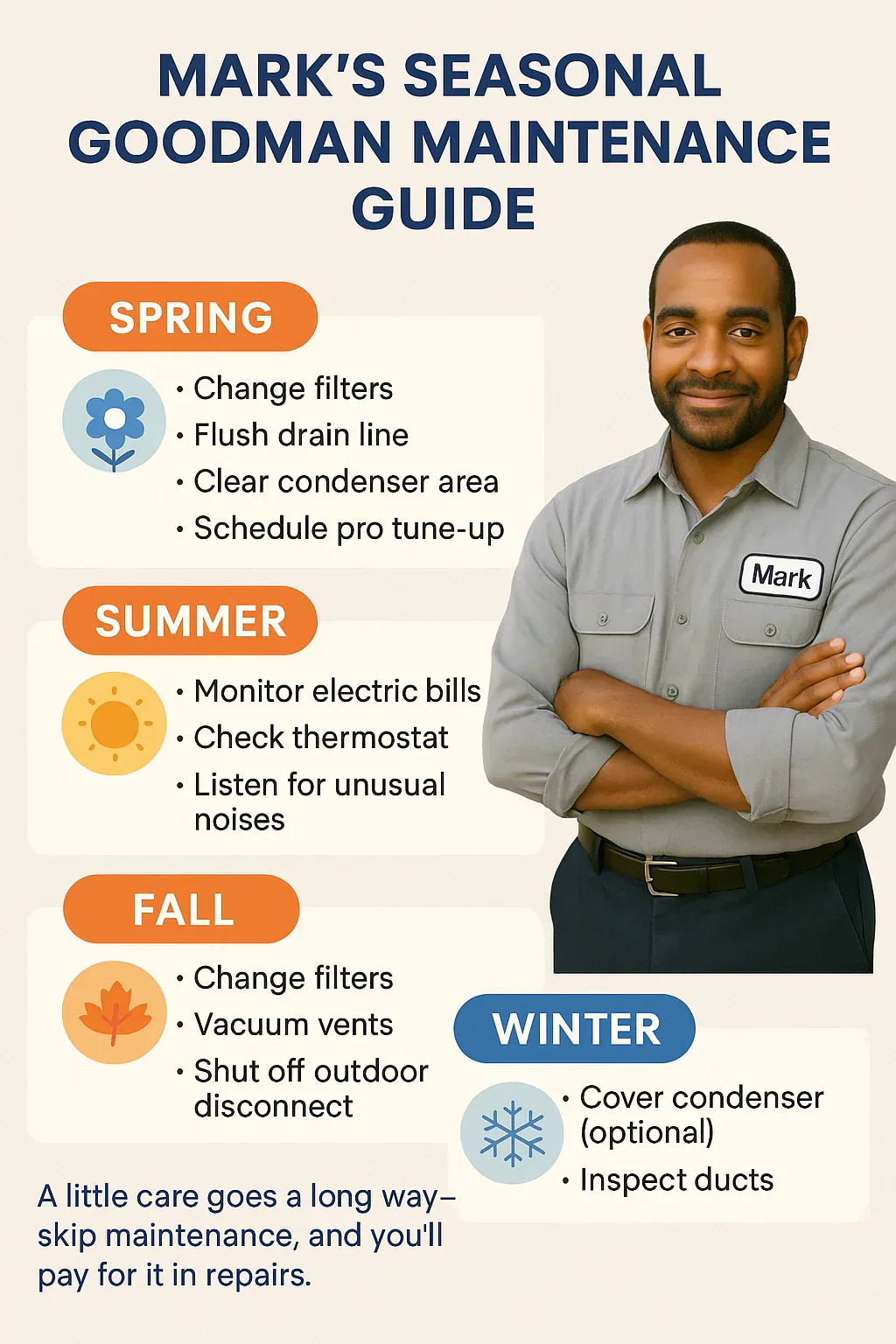By Mark Callahan, HVAC Installation Expert
I’ve installed hundreds of Goodman systems across the Northeast, and if there’s one thing I tell every homeowner, it’s this: your new AC is only as good as the maintenance you give it.
A Goodman 2.5 Ton 13.8 SEER2 Northeast System (GLXS3BN3010 condenser + AMST30BU1300 air handler) is built tough. But like any machine, it needs care to stay efficient and reliable for 15–20 years. Skip maintenance, and you’ll end up with higher energy bills, expensive repairs, and a system that may fail in half the time.
This guide breaks down the maintenance tasks I recommend—what you can safely do yourself, and what’s best left to a pro.
🔑 Why Maintenance Matters
A central AC doesn’t just “run” when you turn it on. It:
-
Pulls warm air from your home.
-
Moves it through filters and coils.
-
Releases heat outdoors via the condenser.
👉 Over time, dirt, dust, and moisture clog filters, coat coils, and stress parts. Even a small drop in airflow or refrigerant charge can cut efficiency by 5–15%.
That’s money out of your pocket every month. Worse, neglected systems often suffer from:
-
Frozen coils.
-
Burned-out compressors.
-
Leaky ducts.
Energy.gov confirms regular maintenance prevents performance decline.
📅 Monthly & Seasonal DIY Tasks
These are the simple steps homeowners can (and should) do themselves.
🪣 Replace Filters (Every 1–3 Months)
-
Dirty filters restrict airflow and force the blower to work harder.
-
Goodman recommends MERV 8–11 filters for most systems.
-
If you have pets or allergies, check monthly.
💡 Mark’s Tip: Don’t wait for filters to “look dirty.” A clean filter costs less than a clogged one burning up your blower motor.
🌿 Keep the Outdoor Condenser Clear
-
Clear at least 2 feet around the unit.
-
Remove leaves, grass clippings, and debris.
-
Trim shrubs that block airflow.
🎛️ Thermostat Check
-
Switch to cooling mode before summer starts.
-
Use programmable or smart thermostats for savings.
-
Keep temps steady (recommended: 78°F when home, 82°F away).
🛠️ Annual Homeowner Checks
These tasks take a bit more effort, but you can still handle them safely.
🌬️ Clean Supply & Return Vents
-
Vacuum vents and grilles to keep dust from cycling back.
-
Avoid blocking airflow with furniture or rugs.
💧 Flush Condensate Drain Line
-
Clogged drains cause water leaks and mold growth.
-
Pour a 1:1 vinegar and water solution down the drain line once per summer.
📏 Inspect Ductwork
-
Look for loose or disconnected sections.
-
Seal gaps with mastic or foil tape (never cloth duct tape).
-
Add insulation to ducts in attics or basements.
👉 Leaky ducts waste 20–30% of conditioned air, according to ENERGY STAR.
🧑🔧 Pro-Level Maintenance (Once a Year)
This is where I come in—or any qualified HVAC tech.
🌀 Coil Cleaning
-
Evaporator coil (inside): absorbs heat. Dust buildup reduces heat transfer.
-
Condenser coil (outside): releases heat. Dirt and pollen clog fins.
-
We use coil cleaner, soft brushes, and fin combs to restore efficiency.
❄️ Refrigerant Charge Check
-
Goodman units must be charged to precise specs.
-
I measure superheat and subcooling to verify correct refrigerant levels.
-
Too low = frozen coils. Too high = compressor damage.
EPA refrigerant handling safety.
⚡ Electrical Inspection
-
I check capacitors, relays, and contactors for wear.
-
Loose wires are tightened.
-
Breaker amperage is verified against Goodman’s rating plate.
🌬️ Airflow Testing
-
Static pressure measured across ducts.
-
Target airflow: 350–400 CFM per ton (~1,000 CFM total).
🚨 Signs of Trouble to Watch For
If you notice any of these, call a pro:
-
Short cycling: System turns on/off too often.
-
Uneven cooling: Some rooms stay hot.
-
Water leaks: Condensate line may be clogged.
-
High electric bills: Could be dirty coils or low refrigerant.
-
Strange noises: Buzzing = electrical. Hissing = refrigerant leak.
Consumer Reports troubleshooting tips.
📈 How Maintenance Extends System Life
Here’s what I’ve seen over the years:
-
Well-maintained Goodman systems: 15–20 years.
-
Neglected systems: 8–12 years.
👉 That’s almost double the lifespan.
Efficiency also stays higher. A tuned-up 13.8 SEER2 system keeps its rating. A neglected one quickly performs like a 10 SEER.
💵 Maintenance Costs
Homeowners often ask, “Mark, how much should I budget each year?”
DIY Costs
-
Filters: $60–$120/year
-
Vinegar for drain flush: $5
Pro Service Costs
-
Annual tune-up: $100–$200
-
Coil cleaning (if heavy buildup): $150–$300
-
Emergency repair (if neglected): $300–$1,200
👉 Prevention is always cheaper than repairs.
🌦️ Mark’s Seasonal Maintenance Checklist
Here’s how I break it down for Northeast homeowners:
🌸 Spring
-
Change filters.
-
Flush drain line.
-
Clear condenser area.
-
Schedule pro tune-up.
☀️ Summer
-
Monitor electric bills for spikes.
-
Check thermostat calibration.
-
Listen for unusual noises.
🍂 Fall
-
Change filters.
-
Vacuum vents.
-
Shut off outdoor disconnect if not using AC.
❄️ Winter
-
Protect condenser with a breathable cover (optional).
-
Inspect ducts for leaks before heating season
✅ Bottom Line: Maintenance = Peace of Mind
Your Goodman 2.5 Ton 13.8 SEER2 system is designed to handle Northeast summers—but only if you help it out with regular care.
-
DIY monthly tasks keep airflow steady.
-
Annual pro service protects efficiency and warranty.
-
Early attention to warning signs saves thousands in repairs.
👉 My rule: “A little care goes a long way. Skip maintenance, and you’ll pay for it in repairs.”
In the next topic we will know more about: Troubleshooting Guide: What to Do If Your 2.5 Ton Goodman AC Isn’t Cooling Right







